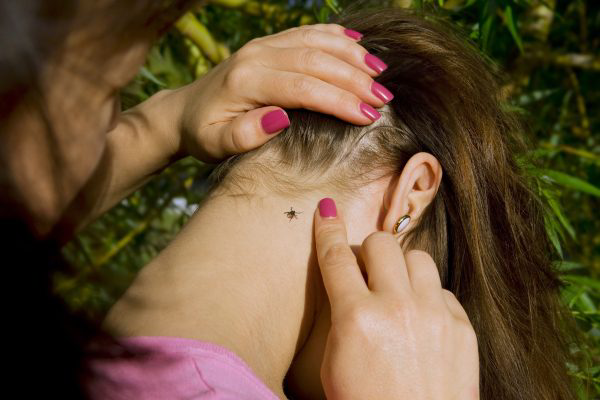
Mosquito Joe provides insights on detecting tick bites.
|
Heading home from a camping trip, you notice a small, hard bump on the back of your neck. Using a mirror, you see a slight red swelling with a dark center and… Eww! Are those legs? Sorry — that is what a tick bite looks like when the tick remains embedded in your skin. The dark spot is the tick’s body, with the head of the tick under your skin. It will be flat if the bite is fresh, but the tick’s body will swell up to ten times its size as it feasts on your blood (ugh!).
Don’t panic. Remain calm, and learn how to carefully remove the tick properly.
Between climate change and loss of habitat, we’re experiencing a significant uptick in tick bites and tick-borne diseases. Knowledge is power, so let’s talk ticks. Learn how to detect ticks, what a tick bite looks like, how ticks get on you in the first place, and what tick bite symptoms feel like.
Understanding Tick Behavior and Habitats
All you have to do to keep from getting bitten is to avoid tick country, right? Unfortunately, that won’t cut it because ticks no longer live exclusively in the woods. Ticks live where animals live and where humans and pets love to play. Ticks inhabit tall grasses, brush, and trees. They are especially found in wooded areas where you find deer and rabbits, which also happen to be our favorite spots for camping, hiking, hunting, and fishing. Ticks can also reside in city parks and other green spaces and love hanging out on brush along the beach and are ready to hitch a ride on your pets.
Increasingly, people are encountering ticks in their own backyards and. As new construction encroaches on tick habitat and wildlife come onto your property looking for an easy meal, ticks become a menace on your property.
How Do Ticks Get on You?
Ticks can detect a host by their breath, or by sensing body heat, odor, moisture, or vibrations. Some species notice changes in light and are able to recognize a shadow. They choose areas that frequently come into contact with other living beings, like the tips of grasses or ends of tree leaves. And then they wait, grasping the plant with their back legs.
This unique hunting behavior is called questing. The tick senses the animal’s (or human’s) approach, then grasps the passing host with its front legs, releasing its hold on the leaf it was waiting on and climbing onto the host. Ticks do not fly or jump, so you must make physical contact with a tick for it to climb onto you. Some ticks attach quickly, while others wander to find places to attach where the skin is thinner.
Can You Feel a Tick Bite?
Surprisingly, most people never feel a tick bite. A tick can range in size from a tiny poppy seed to a pencil eraser, depending upon its life cycle stage, so most of the time a tick is so small that you won’t even feel one crawling on your skin. It’s also tough to tell if you’ve been bitten because most tick bites don’t cause any itching or immediate skin irritation unless you have an allergic reaction. Since you often can’t feel a tick bite, it can be especially tricky to catch. So why are tick bites usually painless?
Tick saliva contains several impressive components that make a bite harder to detect. These include immunosuppressants and powerful and complex numbing agents that degrade pain-inducing molecular signals in a host. These enable the tiny arachnid to avoid detection while it feeds on its host. The tick’s super saliva allows it to bypass several critical defenses to drink its host’s blood in peace for up to ten days. Medical science is studying tick spit to better understand the human immune system.
Common Tick Bite Symptoms
Because you usually can’t feel a tick bite at first, it’s important to know tick bite symptoms. That way, if you notice any of them, you can take action as soon as possible. The following symptoms are the ones you need to take very seriously. They may be signs that the tick has infected you with a tick-borne disease or that the bite has become infected.
Redness, Swelling, or Crust
Tick bites sometimes swell and turn red, looking like a small mosquito bite. You may also notice a small scab develop around the puncture site. This is normal. However, if the bite develops a dark sore or crusty spot after a couple of weeks, this may be a sign of African tick bite fever and should be reported to your doctor. Additionally, significant redness and swelling, especially when accompanied by severe pain, can indicate infection or other problems. See a doctor if this occurs.
Skin Rash
Some rashes caused by tick bites can indicate infection. Small reddish or purplish spots can occur with Rocky Mountain spotted fever. A red bullseye rash is a telltale sign of Lyme disease, present in 70% of infections. The rash often feels warm but typically does not itch or hurt. In rare cases, there may be a burning sensation or a crusty outer ring. Bullseye rashes continue to spread over several days. Regardless of its appearance, any rash following a tick bite warrants a visit with your doctor.
Symptoms requiring emergency medical care
In some cases, a tick bite can cause serious allergy, disease, or infection. If you experience any of the following symptoms after a tick bite, call 911.
- A severe headache
- Difficulty breathing
- Paralysis
- Heart palpitations
- Uncoordinated movement
- Weakness
Effective Methods to Detect Ticks on Your Body
Since you cannot feel a tick bite or even feel a tick crawling on you, it’s essential to learn how to detect ticks. The first step is to look for both ticks and bites regularly after you’ve been in an area where ticks live. The second step is to know what you’re looking for. (Brace yourself.)
Early Stage Tick Bites
A tick bite often resembles a small red bump, much like a mosquito bite or a small pimple, for one to two days following the bite. Unless it is infected, there will be no fluid or pus. Ticks prefer to bite in warm, moist spots, like armpits, behind the knee, between the toes, in the groin, and near or in the hair. The tick itself is small, flat, and dark. Its legs are visible in an early-stage bite before the body swells with blood, blocking your view of those legs. (Ick). At that point it looks like what it is: a tiny arachnid.
Ticks Under Skin
You’ll never see a whole tick under your skin, but it’s important to know how to detect ticks that have embedded their head in your skin. A tick embeds its mouthparts into the flesh of a host when it bites, holding fast using a cement-like protein and a barbed feeding tube. As the tick engorges with blood, it can swell from the size of a sesame seed to the size of a pea. If the tick has already detached, you may see an area of redness around the bite site.
Regardless of the size of the tick, it’s important not to crush it while removing it. A tick that has not attached yet can simply be removed with tweezers or gloved fingers. An attached tick requires careful removal with tweezers or forceps. Gently pull out the tick from as close to the head as possible, using a slow, steady upward motion. Do not twist or squeeze. Once removed, wash your hands and the bite thoroughly with soap and water. Then, take a picture of the tick, put it in a closed container, and bring it to your doctor.
Related blog: How to Remove a Tick from a Dog?
Preventative Measures to Avoid Tick Bites
Now you know how to detect ticks and what a tick bite looks like. If our tick talk has left you feeling squeamish — never fear! Mosquito Joe® is here for you, and we know how to combat ticks. Let our professionals come in and take care of these creepy crawlies for you.
Ready to learn how to get rid of ticks in your yard? Our Mosquito Joe services have you covered. Our professional tick yard treatment can tackle those pesky blood-suckers for you, so you don’t have to live with the heebie-jeebies.
Your local Mosquito Joe’s comprehensive pest control services are dedicated to making your outdoor spaces fun again, free from the bites, stings, and harassment from various bugs and insects.
We know you’ll be tickled with our tick control service because everything we do is backed by the Neighborly Done Right Promise® and the Mosquito Joe Satisfaction Guarantee. We take pride in our work and we want to make sure you feel that you can trust us every step of the way.
Don’t get ticked off by these tiny pests — request a free estimate. Call Mosquito Joe today!
Tick Bite FAQs
Since 2010, Mosquito Joe professionals have protected families like yours from nasty biters that would have you itching and scratching your way through summer. As an industry leader dedicated to environmentally sound pest control, we’re happy to use our many years of experience to answer some of your most frequently asked questions about ticks.
Can a tick bite look like a pimple?
Yes, once the tick detaches, a tick bite often looks like a pimple, without pus or fluid, unless the bite is infected. You may also see a small scab at the puncture site.
What are the concerning signs after a tick bite?
Any rash surrounding a tick bit is concerning. If a bull’s eye rash forms after a tick bite, it’s a sign that Lyme disease was transmitted by the tick. A bullseye rash has red swelling in the center, which is surrounded by unaffected skin and is ringed with a red circle. Other concerning signs include fever, body aches, sore joints, swollen lymph nodes, and lethargy. Also, look out for dark sores or crustiness at the site of the bite.
This article is intended for general informational purposes only and may not be applicable to every situation. You are responsible for determining the proper course of action for your home and property. Mosquito Joe is not responsible for any damages that occur as a result of this blog content or your actions. For the most accurate guidance, contact your local Mosquito Joe location for a comprehensive, on-site assessment.
